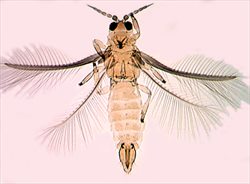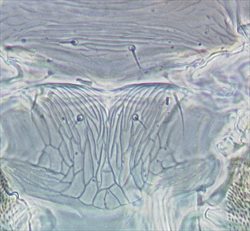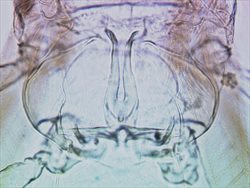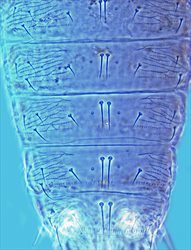
Female

Head & pronotum

Head

Antenna

Antenna

Meso & metanota

Metathoracic furca

Hind tibia & tarsus

Fore wing

Tergites IV–VIII
Both sexes fully winged. Body and legs white, fore wings uniformly dark or black, antennal segment II dark, III–VII brown. Antennae 7-segmented, VII slender and longer than VI; sense cone forked on III–IV, segment VI with long simple sense cone arising close to base on inner margin. Head lacking sculpture. Pronotum transversely striate, with 2 pairs of prominent postero-angular setae. Metanotum with linear sculpture lines converging medially, median pair of setae small and arising medially; metathoracic furca extending into mesothorax. Tarsi all 1-segmented. Fore wing slender, pointed; first vein with 2 widely spaced setae on distal half, second vein without setae, postero-marginal cilia straight. Abdominal tergites II–VIII median setae long and close together; lateral thirds of tergites with transverse lines of sculpture bearing widely spaced, small microtrichia; VIII with postero-marginal comb of microtrichia. Sternites III–VII with 3 pairs of long postero-marginal setae.
Male with sense cone simple on antennal segments III–IV; sternites without pore plates.
Five species, all particularly pale in their body colour, are recognized in the genus Leucothrips. One of these, nigripennis, is widely distributed around the world (Mound, 1999), one is known only from North America, but of the three species from the Neotropics two have been distributed across the Pacific to Hawaii and Japan (Masumoto & Okajima, 2017b). As with other species of the Dendrothripinae, the metathoracic furca is enlarged and lyre-shaped, extending to the mesothorax.
Feeding, breeding and pupating on the fronds of various species of ferns.
Probably originally from South America, this species has been introduced widely around the world, and has been recorded in temperate greenhouses from a number of European countries as well as from the USA (zur Strassen, 2003). However, in Britain it has not been encountered since 1909 after being found on fern under glass in Newcastle (Bagnall, 1909a; Collins, 2010a).
THRIPIDAE - DENDROTHRIPINAE
Leucothrips nigripennis Reuter
Leucothrips nigripennis Reuter, 1905: 108
Microthrips leucus Herrick, 1927: 278
Sporangiothrips acuminatus Daniel, 1985: 195
Bagnall RS (1909a) A contribution to our knowledge of the British Thysanoptera (Terebrantia), with notes on injurious species. The Journal of Economic Biology 4: 33–41.
Collins DW. (2010a) Thysanoptera of Great Britain: a revised and updated checklist. Zootaxa 2412: 21–41.
Masumoto M & Okajima S (2017b) Studies on Dendrothripinae (Thysanoptera, Thripidae) from Japan, with new records and one new species. Zootaxa 4362 (3): 405–420.
Mound LA (1999) Saltatorial leaf-feeding Thysanoptera (Thripidae: Dendrothripinae) from Australia and New Caledonia, with newly recorded pests of ferns, figs and mulberries. Australian Journal of Entomology 38: 257–273.
zur Strassen R (2003) Die terebranten Thysanopteren Europas und des Mittelmeer-Gebietes. Die Tierwelt Deutschlands 74: 1–271.